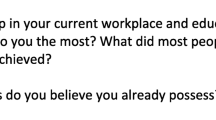Abstract
This article presents information on a new, successful, leadership development program designed to target and strengthen key performance skills. The technology outlined in the article couples pedagogy with video and computer technology. The resulting Professional Enhancement Program (PEP) has demonstrated its effectiveness for improving the performance of prospective and practicing school leaders and is currently used in twenty sites across seven states in the United States.
Similar content being viewed by others
References
Andrews, S.V. (1992, February). Enhancing Learning and Scholarship in the College Classroom: The Role of Learning Teams. Paper presented at the Annual Meeting of the American Association of Colleges for Teacher Education, San Antonio, TX.
Barnett, B.G. (1985). Peer-Assisted Leadership: Peer Observation and Feedback as Catalysts for Professional Growth. In J. Murphy & P. Hallinger (Eds.), Approaches to Administrative Training in Education. Albany, NY: State University of New York Press.
Byham, W.C. (1980). Starting an Assessment Center the Correct Way. Personnel Administrator, 25(2), 27–32.
Caughlin, J.F. (1997, Fall). Peer Assessment and Learning in a Technology-Assisted Leadership Development Center. Unpublished doctoral dissertation, George Mason University, Fairfax, Virginia.
Cooper, J.L. (1995). Cooperative Learning and Critical Thinking. Teaching of Psychology, 22(1), 7–9.
Downey, R.G., & Duffy, P.J. (1978, October). Review of Peer Evaluation Research. Arlington, VA: U.S. Army Research Institute for the Behavioral and Social Sciences.
Goleman, D. (1998). Working with Emotional Intelligence. New York: Bantam Books.
Goldfinch, J., & Raeside, R. (1990). Development of a Peer Assessment Technique for Obtaining Individual Marks on a Group Project. Assessment and Evaluation in Higher Education, 15(3), 210–231.
Guerrero, F. (1990). Collaborative Learning and Computers: What Some New York City Teachers are Doing, 1988–1989. Brooklyn, NY: Office of Research, New York City Board of Education.
Hollander, E.P. (1964). The Validity of Peer Ratings from Officer Candidate School (OCS) in Predicting Officer Performance: A Follow-up of the 1955 Newport Study (Contract No. NONR816 12). Washington, D.C. and St. Louis, MO: U.S. Department of the Navy and Washington University.
Hoyle, J.R., English, F.W., & Steffy, B.E. (1998). Skills for Successful 21st Century School Leaders: Standards for Peak Performers. Arlington, VA: American Association of School Administrators.
Imel, S. (1991). Collaborative Learning in Adult Education. Washington, D.C.: Office of Educational Research and Improvement, U.S. Department of Education.
Interstate School Leaders Licensure Consortium (ISLLC) (1996). ISLLC Standards for School Leaders [Online]. Council of Chief State School Officers. Available: http://www.ccsso.org/pdfs/isllcstd.pdf
Lepard, D.H. (1988). The Validity and Reliability of Assessment Centers. Paper presented at the SCEA Research Conference, Orange, CA.
Lepard, D.H. (1990, Spring). The Use of Video Technology in Assessment Center Evaluation of Participants. Paper presented at the 18th International Congress on Assessment Center Methodology, Orange, CA.
Lepard, D.H. (1993, Spring). A Marriage of Videotape Documentation and Computerized Scoring. Paper presented at the 21st International Congress on the Assessment Center Method, Atlanta, GA.
Lepard, D.H. (1994, Spring). A Closer Look at Self-Scoring as a Development Tool. Paper presented at the 22nd International Congress on Assessment Center Methodology, San Francisco, CA.
Lepard, D.H. (1995, July). A Study of Computer-Assisted Self-Assessment for Management and Leadership Development. Published paper presented at the Ed Futurum Conference in Bloemfontein, University of Orange Free State, Republic of South Africa.
Lepard, D.H., & Caughlin, J.F. (1995, December). Computer-Assisted Peer Assessment and Development: Design for Leadership. The Bulletin of the National Policy Board for Educational Administration, 6(2), 1–6.
Medland, F.F., & Olans, J.L. (1964). Peer Rating Stability in Changing Groups (Report No. APRO-TRN-142; Contract No. DA-2PJP024701-A-722). Washington, D.C.: U.S. Army Personnel Research Office.
Prichett, J. (1991). Training the Assessors: Process Can Enrich Management Techniques. NASSP Bulletin, 70(34).
Thomson, S.D. (Ed.) (1993). Principals for Our Changing Schools: The Knowledge and Skill Base. Fairfax, VA: National Policy Board for Educational Administration.
Thornton, G., & Byham, W. (1982). Assessment Centers and Managerial Performance. New York: Academic Press.
Walberg, H.J. (1992). The Knowledge Base for Educational Productivity. International Journal of Educational Reform, 1(1), 5–15.
Author information
Authors and Affiliations
Rights and permissions
About this article
Cite this article
Lepard, D.H. Using Peers and Technology to Strengthen Leadership. Journal of Personnel Evaluation in Education 16, 11–28 (2002). https://doi.org/10.1023/A:1019983724987
Issue Date:
DOI: https://doi.org/10.1023/A:1019983724987




